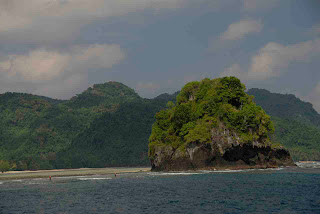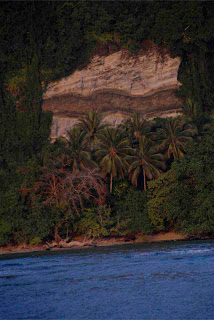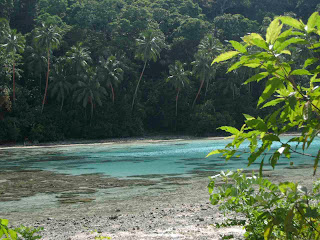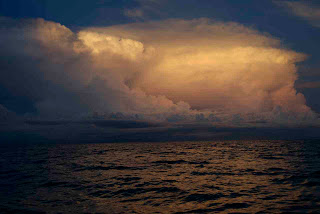Had a few days in the Russels but I'll come back to
that as I have been busy resupplying the boat and
not able to connect to the internet in town! Now I
am relating the passage over 500nm to one of the
most remote islands in the Solomons, the Duff group out East.
Pics to come next time I can connect! :)
May 15th. Honiara.
The anchorage in front of the yacht club in Point
Cruz is not much of an anchorage in fact with room
for three yachts, two of them being on moorings and
the rest of available depths 20m or more, close to a
reef shoal, or too close to the police boats jetty,
which need turnaround space, the whole lot open to
the afternoon northerly squalls! KUNA had no choice
but to pick up a mooring (upon advice of the two other
yachties) hoping the owner would not get too upset if
we stayed a couple of days and that it was a decent
mooring (to deep to check on snorkel though!)
Once upon a time, this town my have been a nice spot but
it is now looking rather mad. It is basically one long
road between the shore and the hills going from the
airport strip to the less populated marshy land to the
west, with a thick flow of cars driving the third world
style! Across the water form the anchorage, the yacht
club is a bit of a haven with 24 hours security guards
and great fish and rice meals for cheap, a good contrast
to the sterile luxury of the Mendana hotel next door
along the beach (though nice to pull up there by kayak
for a nice meal too!). It is easy to pull up there with
the dingy and get some fuel from the petrol station 100m
away and cross the road to try and find decent supplies
in the chinese supermarket. Imported food cost a mint here,
so does "bush kaikai" (ie custom fruit and vegies, all
the traits of booming city. Apparently, rents in Honiara
is as costly relatively as in WashingtonDC!
Saturday May 17th
4PM S 09¼ 22.8 E 16011.4
Left Honiara in next to no wind, strangely enough as all
the previous days, the build-up of heat above this high
land (2500m is the highest mountain) normally attracted
a nice 15 knots N-NE breeze in the afternoon, but today
no luck and just blazing heat in which we had to motor.

The sea was mirror calm, which was perfect for spotting
whales. At least 12 Minkies were spotted in Iron Bottom
sound and Lengo channel further to the East. The north
coast of Guadalcanal has a number of capes to round
before heading to the SE but none of the charted lights
were sighted. The tide streams did the unexpected so
ended up pushing two knots of current, The tidal regime
changes from diurnal in Honiara to semi diurnal in the
Lark channel 20 miles away, and but possibly the tidal
predictions out though I am not too sure!
Sunday May 18th
12 Noon, S 09¼ 47.9 E 161¼36.6
After heading South East all night (motoring and light
NW breeze with spinnaker on at the end of the night),
in the morning, rounded the south east end of Malaita
island which has a reef and a couple of rocks sticking
out. Pass this point, it was possible for the Kuna to
take the route straight east to the Duffs, some 325 mile
away, following just north of the 10th parallel (easy
one to plot!). Ulawa island some 20 miles further east is
the last before a long stretch of open sea where swells
from NW and S-SE are now felt. It was a change, after
the well protected waters of the "slot" (New Georgia
sound) and Indispensable Straight. Too well protected
in fact, which made for the absence of wind in the last
month! It is now pretty enjoyable to be able to SAIL
- for real!- in light NW winds, with open ocean
influences rather than desperately trying to catch
katabatic winds off steep volcanic islands (though
tropical katabatics are much nicer than the Antarctic
ones!).
Monday May 19th
12 Noon, S 09¼ 55.6 E 163¼26.3
Now the wind has turned westerly as it looks like we
are following a low pressure system, though very light.
We the headsail poled out, it is possible to do 4.5
knots straight East but it is a struggle with the rig
bashing whenever the Kuna is loosing speed. Lucky we
unloaded most of the camera gear in Honiara (and sadly
the dive compressor and surfboard) as the loss of
weight made for performance for sure!! A slow zig zag
course was followed most of the day, except for one
squall, which gave us all a good shower and 10 L of
drinking water, and increased the watch average from
10 miles to 15!!. The wind slowly turned to the South
as predicted by the grib, finally making it possible
for sailing on course, at 5-6 knots and without
bashing the rig.

KUNA crossed a mine field of fishing lines at about
2 pm, something you would not want to run into at
night because the buoys have absolutyely no lights,
or signally device. There was 4 no boats patrolling
in the area, laying lines and retrieving them, so
their lights would be the only way to tell at night,
hoping they do't stay too far away from the lines!
The deep grounds 60 miles east of Ulawa Island are
up to 4000 m deep!






































